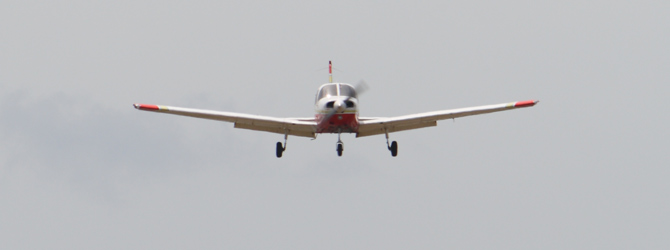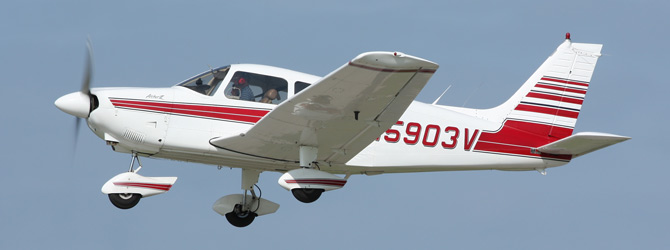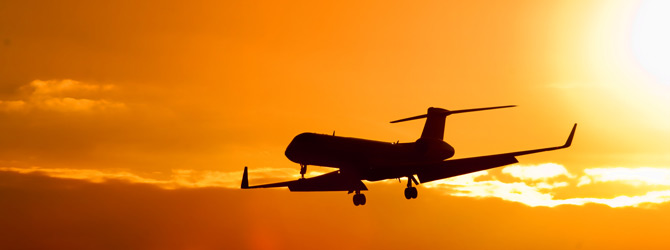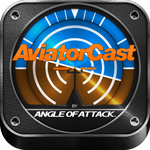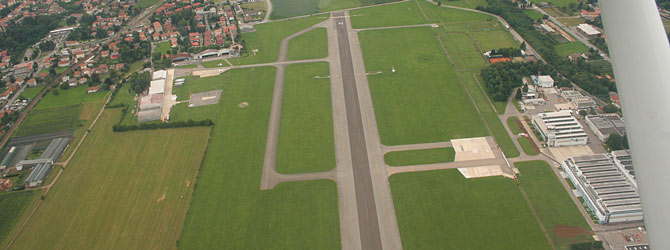
Add some excitement to your practice routine
I try to get up at least once a week to keep my proficiency, and many times I only have 30 – 45 minutes of actual time in the air, so I try to stretch that time and get as much utility as possible. Lately I’ve been focusing on a few maneuvers to spice up the pattern a little bit, and I want to walk you through a few. Your technique may be a bit different, but in general the outcome of each should be the same. Try one or two next time you’re up in the sim, it can really make for some exciting pattern work.
Power Off Landing
This one’s a commercial maneuver that my CFI had me learn pretty early on, even in my PPL training. The point is to be able to land on a given spot (within 200’) without the ability to correct using your throttle. Get yourself situated on downwind at pattern altitude, then pick your aiming point on the runway (I usually use the 1,000’ bars to make it easy to see). When you are parallel to your landing point, pull the throttle smoothly out (or since it’s a sim, kill the engine!), then pitch for best glide. Shortly after you cross parallel to the threshold, begin your base and short final turns – you should be done turning BEFORE you get over the runway. Now you can judge your height and add flaps as necessary, or slip in if you are high enough (I love slipping on short final like this, it’s pretty thrilling and a real test of stick and rudder skills). Remember you CAN’T gain ground, so coming in high is ok. The point is also not to grease the landing, but rather to get it safely down plus or minus 200 feet from the intended point of landing. A hard landing is better than a long one since you are practicing for a time when you man not have the option of landing long.
This is one of my favorites to practice on the sim because I can pull the mixture and kill the engine, and then truly not have the option to add some juice if I mess up – not so in the real world, and I think there’s a psychological effect to always having an out.
No Flap Landing
The first night flight I did was only several hours into my PPL training. We started with some of the ground reference maneuvers and my CFI coached me through some of the differences; then we practiced a few stalls – both approach and takeoff configuration stalls. He asked me to put the plane back into approach configuration, so I pulled the throttle gently back, trimming to stay level, then when the airspeed was low enough added a notch of flaps. When I added the second notch of flaps, there was a visible spark behind the flap lever and both my CFI and I glanced at each other, rather startled. He reached over and flipped the lever into varying positions, and the flaps did nothing, they were stuck at about 5 degrees, maybe a touch less. He looked over at me, grinned, and said “Time to practice slips!”
So I learned how to slip for a while – and, more importantly, I learned to slip to a landing.
Set yourself up in a typical pattern, but don’t add flaps as you reduce power crossing parallel to the threshold on downwind. Once you are at best glide speed, reduce power just a touch more than you usually would, but otherwise continue as usual. Turning final you will likely be high – jam the rudder away from the crosswind (if there is one) and tip the wings into the wind to counter the turning tendency – look out your window and track centerline using your ailerons; you should be in a pretty hard dive at this point without gaining much speed – you can nose over if you are losing speed. Once you are back on glideslope, slowly release control pressure on ailerons and rudder and line yourself up – you should be at a good approach speed at this point. If you are high enough, you can slip all the way to the threshold before leveling out. This is great practice also for crosswind landings as you’ll get comfy with that slip. It’s neat to me that in the sim it feels unnatural, particularly if you’re using rudder pedals and a yoke; it feels equally unnatural in the real world to be flying with the controls crossed up, but it’s exhilarating to pop out of the slip, feel (and flight) the slight balloon tendency and then grease it in right on centerline.
Dogleg Approach
I was coming in to KIDA from over the foothills to the east, initially cleared for a left base to runway 20. From where I was, I essentially aimed directly for the approach end of 20 which set me up for a 45 degree right turn into the base leg. I was just about to turn for a 2 mile base when a regional called in on a 15 mile final (visual) for 20. At our moderately busy but very small airport, regionals are given priority handling the vast majority of the time – and most of us have to take those shuttles in and out so we are happy to step aside. The tower controller asked me for a position report, and then asked if I’d take a short approach. I responded in the affirmative, at which point he cleared me for a dogleg approach to 20. Luckily I’d read that one, but I had certainly never practiced it. At 45 degrees to 20 I was already set up pretty well, so I pulled the throttle back, pitched for best glide and added flaps as though I was on final. I aimed for about 200 yards off the approach end of 20, then made a quick turn and was down and off before the regional called short final.
This one’s fun to practice – and it’s good old pilotage and stick & rudder since you won’t be able to see the VASI or PAPI’s until you are just about to cross the threshold. Look out the window, fly by the numbers, and make sure you’re high enough when you do turn that it’s safe if something goes wrong. The idea is to shorten your approach, typically to allow for traffic. It’s a great skill to have and a huge boon to ATC if you can help them out when they need it.
Pattern Work in the Sim
I know it can get old in FSX, even if you’ve booted into the latest ORBX or FlyTampa airport, to take off and land at the same runway over and over – but the skills learned from repetition are well worth it. That said, if you just can’t handle another circuit, find yourself a stretch of airports that are within 10 – 15nm of each other and pop back and forth – practice good form with your entries if you’re not being controlled (most of these will probably be class D or E), 45 degrees to the downwind or base on entry, and a 45 exit from upwind or a downwind departure. Gives you half of the pattern at each airport and allows you to get a little navigation in along the way.
Just because I know them, I’ll fly KIDA – U56 – KRXE – U12 and back.
Happy pattern work!
This article was posted in Angle of Attack, Blog, Flight Simulator, Flightsim Tips, Maneuvers, Real World
Please note: We reserve the right to delete comments that are snarky, offensive, or off-topic. If in doubt, read the Comments Policy.

